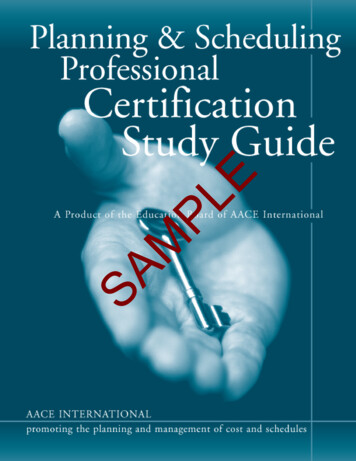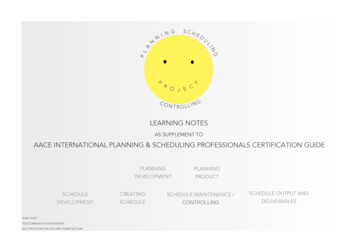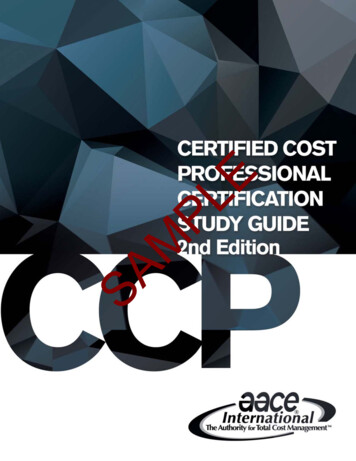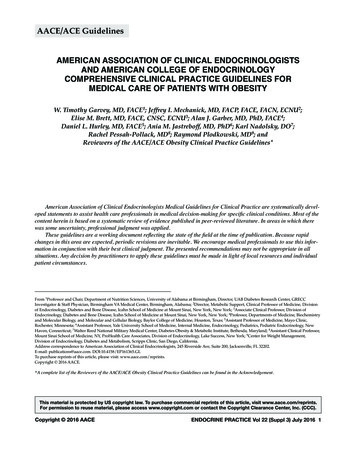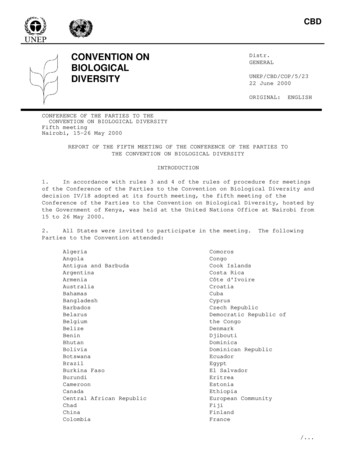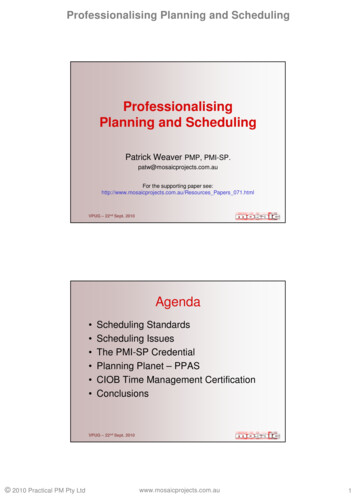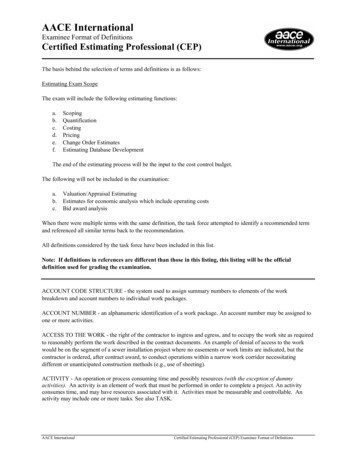
Transcription
AACE InternationalExaminee Format of DefinitionsCertified Estimating Professional (CEP)The basis behind the selection of terms and definitions is as follows:Estimating Exam ScopeThe exam will include the following estimating PricingChange Order EstimatesEstimating Database DevelopmentThe end of the estimating process will be the input to the cost control budget.The following will not be included in the examination:a.b.c.Valuation/Appraisal EstimatingEstimates for economic analysis which include operating costsBid award analysisWhen there were multiple terms with the same definition, the task force attempted to identify a recommended termand referenced all similar terms back to the recommendation.All definitions considered by the task force have been included in this list.Note: If definitions in references are different than those in this listing, this listing will be the officialdefinition used for grading the examination.ACCOUNT CODE STRUCTURE - the system used to assign summary numbers to elements of the workbreakdown and account numbers to individual work packages.ACCOUNT NUMBER - an alphanumeric identification of a work package. An account number may be assigned toone or more activities.ACCESS TO THE WORK - the right of the contractor to ingress and egress, and to occupy the work site as requiredto reasonably perform the work described in the contract documents. An example of denial of access to the workwould be on the segment of a sewer installation project where no easements or work limits are indicated, but thecontractor is ordered, after contract award, to conduct operations within a narrow work corridor necessitatingdifferent or unanticipated construction methods (e.g., use of sheeting).ACTIVITY - An operation or process consuming time and possibly resources (with the exception of dummyactivities). An activity is an element of work that must be performed in order to complete a project. An activityconsumes time, and may have resources associated with it. Activities must be measurable and controllable. Anactivity may include one or more tasks. See also TASK.AACE InternationalCertified Estimating Professional (CEP) Examinee Format of Definitions
Cost Engineering Terminology2 of 19ACTS OF GOD - (1) an extraordinary interruption by a natural cause, as a flood or earthquake, or the usual courseof events that experience, foresight or care cannot reasonably foresee or prevent; (2) an event in nature over whichneither the owner nor the contractor has any control.ACTUAL COSTS - the actual expenditures incurred by a program or project.ADDENDA - written or graphic instruments issued prior to the date for opening of bids which may interpret ormodify the bidding documents by additions, deletions, clarification, or corrections.ADMINISTRATIVE EXPENSE - See General & Administrative ExpenseALLOWANCES (ESTIMATING) - resources included in estimates to cover the cost of known but undefinedrequirements for an individual activity, work item, account or subaccount.AMENDMENT - a modification of the contract by a subsequent agreement. This does not change the entire existingcontract but does alter the terms of the affected provisions or requirements.ANNUALLY RECURRING COSTS - those costs that are incurred in a regular pattern each year.AUTHORIZED WORK - activity that has been approved to proceed by the client. The scope may or may not bewell defined at the time authorized; it is usually defined by contract.BACKCHARGE - a cost caused by defective or deficient work by the contractor deducted from or used to offset theamount due to the contractor.BACKUP –supporting documents for an estimate or schedule including detailed calculations, descriptions of datasources, and comments on the quality of the data.BASE PERIOD (OF A GIVEN PRICE INDEX) - period for which prices serve as a reference for current periodprices; in other words, the period for which an index is defined as 100 (if expressed in percentage form) or as 1 (ifexpressed in ratio form).BASE POINT FOR ESCALATION - cost index value for a specific month or an average of several months that isused as a basis for calculating escalation.BASELINE - In project control, the reference plans in which cost, schedule, scope and other project performancecriteria are documented and against which performance measures are assessed and changes noted.BASIS – Written documentation that describes how an estimate, schedule, or other plan component was developedand defines the information used in support of development. A basis document commonly includes, but is notlimited to, a description of the scope included, methodologies used, references and defining deliverables used,assumptions and exclusions made, clarifications, adjustments, and some indication of the level of uncertainty.BATTERY LIMIT - comprises one or more geographic boundaries, imaginary or real, enclosing a plant or unitbeing engineered and/or erected, established for the purpose of providing a means of specifically identifying certainportions of the plant, related groups of equipment, or associated facilities. It generally refers to the processing areaand includes all the process equipment, and excludes such other facilities as storage, utilities, administrationbuildings, or auxiliary facilities. The scope included within a battery limit must be well-defined so that all personnelwill clearly understand it. On drawings this is often referred to as inside/outside battery limits or ISBL/OSBL. Seealso OFF-SITES.AACE InternationalCertified Estimating Professional (CEP) Examinee Format of Definitions
Cost Engineering Terminology3 of 19BENCHMARKING - A measurement and analysis process that compares practices, processes, and relevantmeasures to those of a selected basis of comparison (i.e., the benchmark) with the goal of improving performance.The comparison basis includes internal or external competitive or best practices, processes or measures. Examples ofmeasures include estimated costs, actual costs, schedule durations, resource quantities and so on.BENEFICIAL OCCUPANCY - use of a building, structure, or facility by the owner for its intended purpose(functionally complete), although other contract work, nonessential to the function of the occupied section, remainsto be completed. See also SUBSTANTIAL COMPLETION.BID - to submit a price for services; a proposition either verbal or written, for doing work and for supplyingmaterials and/or equipment.BIDDER - the individual, partnership, or corporation, or combination thereof, acting directly or through anauthorized representative, formally submitting a bid directly to the owner, as distinct from a sub-bidder, whosubmits a bid to a bidder.BID SHOPPING - an effort by a prime contractor to reduce the prices quoted by subcontractors and/or suppliers, byproviding the bid price to other subcontractors or suppliers in an attempt to get the other subcontractors or suppliersto underbid the original price quoted. The reverse of this situation is when subcontractors try to get a better price outof a prime contractor. This is known as Bid Peddling.BIDDING DOCUMENTS - the advertisement for bids, instructions to bidders, information available to bidders, bidform with all attachments, and proposed contract documents (including all addenda issued prior to receipt of bids).BIDDING REQUIREMENTS - the advertisement for bids, instructions to bidders, supplementary instructions andall attachments therein, information to bidders and all attachments therein, and bid form and all attachments therein.B.L.S. -Bureau of Labor Statistics.B.L.S. PERIODICALS –CPI Detailed Report, issued monthlyCurrent Wage Developments, issued monthlyEmployment and Earnings, issued monthlyMonthly Labor Review, issued monthlyOccupational Outlook Quarterly, issued quarterlyProducers' Prices and Price Indexes, issued monthly (previously Wholesale Price Index)BONDS - instruments of security furnished by the contractor and/or surety in accordance with the contractdocuments. The term contract security refers to the payment bond, performance bond and those other instruments ofsecurity required in the contract documents.BOND, BID - a bond that guarantees the bidder will enter into a contract on the basis of the bid.BOND, PAYMENT - a bond that is executed in connection with a contract and which secures the payment of allpersons supplying labor and material in the prosecution of the work provided for in the contract.BOND, PERFORMANCE - a bond that is executed in connection with a contract and which secures theperformance and fulfillment of all the undertakings, covenants, terms, conditions, and agreements contained in thecontract.AACE InternationalCertified Estimating Professional (CEP) Examinee Format of Definitions
Cost Engineering Terminology4 of 19BREACH OF CONTRACT - failure, by either the owner or the contractor, without legal excuse, to perform anywork or duty owed to the other person.BUDGET - Estimated resource expenditures during a given period for a project or activity. Resources may includecost, hours, quantities, etc. The budget may also include a systematic plan for the expenditure of the resources.BUDGET ESTIMATE - A budget estimate is prepared with use of flow sheets, layouts and equipment details. (Thisterm is superseded by recommended practice 17R-97, Cost Estimate Classification System)BULK MATERIAL - material bought in lots. These items can be purchased from a standard catalog description andare bought in quantity for distribution as required. Examples are pipe (nonspooled), conduit, fittings, and wire.CASH FLOW - the net flow of funds into or out of a project. The sum, in any time period, of all cash receipts,expenses, and investments. Also called cash proceeds or cash generated. The stream of monetary values -- costs andbenefits -- resulting from a project investment.CHANGE IN SCOPE A change in the defined deliverables or resources used to provide them.CHANGE ORDER From an owners prospective:A change order is a document used for total project cost control. After a project is authorized, changes often occurbefore the project actually gets to the field. To an owner the authorized estimate change orders should give you anew control point in place of the authorized amount. This is also now your new indicated total cost. In actualpractice, change orders (written immediately when a change is identified) are usually a high spot estimate and theactuals do not become available till the work is actually executed in the field. For this reason authorized changeorders do not necessarily end up equaling the final cost - but should be close. When an owner thinks of cost controlthey think "no surprises". Issuing a change order based on minimum data is important to alert management ofpotential changes so that they can react to the potential change by adjusting future project activities to offset thispotential change or agree to accept the additional cost. (could be a reduction in some cases). Owners may havenumerous contracts per project.From a contractor’s perspective:A change order is "An agreement between the owner and the contractor to compensate for a change in scope or otherconditions." An owner would call these contract extra work orders (or something like that) which would eventuallybecome an alteration to the purchase order contract.CHART OF ACCOUNTS - see CODE OF ACCOUNTS.CLAIM - a written statement requesting additional time and/or money for acts or omissions during the performanceof the construction contract. The claim must set forth the facts and circumstances for which the party is responsibleto be entitled to additional compensation and/or time.CODE OF ACCOUNTS (COA) - A systematic coding structure for organizing and managing asset, cost, resource,and schedule activity information. A COA is essentially an index to facilitate finding, sorting, compiling,summarizing, or otherwise managing information that the code is tied to. A complete code of accounts includesdefinitions of the content of each account. Syns.: Chart of Accounts, Cost Codes.AACE InternationalCertified Estimating Professional (CEP) Examinee Format of Definitions
Cost Engineering Terminology5 of 19COMMITTED COST – A cost which has not yet been paid, but an agreement has been written that it will beincurred. Eg. Signed purchase order or contract.CONCEPTUAL ESTIMATE – An estimate made without the benefit of detailed engineering data. (This term issuperseded by recommended practice 17R-97, Cost Estimate Classification System)CONFLICT IN PLANS AND SPECIFICATIONS - statements or meanings in the contract documents (includingdrawings and specifications) that cannot be reconciled by reasonable interpretation on the part of the contractor andwhich may require the owner to provide an interpretation between alternatives.CONSTRUCTION COST - the sum of all costs, direct and indirect, inherent in converting a design plan for materialand equipment into a project ready for start-up, but not necessarily in production operation; the sum of field labor,supervision, administration, tools, field office expense, materials, equipment, and subcontracts.CONSTRUCTION MANAGEMENT -A professional service that applies to effective management techniques to theplanning, design, and construction of a project from inception to completion for the purpose of controlling time, cost, and quality, as defined by the Construction Management Association of America (CMAA).CONSUMABLES - supplies and materials used up during construction. Includes utilities, fuels and lubricants,welding supplies, worker's supplies, medical supplies, etc.CONTINGENCY - An amount added to an estimate to allow for items, conditions, or events for which the state,occurrence, and/or effect is uncertain and that experience shows will likely result, in aggregate, in additional costs.Typically estimated using statistical analysis or judgment based on past asset or project experience. Contingencyusually excludes; 1) major scope changes such as changes in end product specification, capacities, building sizes,and location of the asset or project (see management reserve), 2) extraordinary events such as major strikes andnatural disasters, 3) management reserves, and 4) escalation and currency effects. Some of the items, conditions, orevents for which the state, occurrence, and/or effect is uncertain include, but are not limited to, planning andestimating errors and omissions, minor price fluctuations (other than general escalation), design developments andchanges within the scope, and variations in market and environmental conditions. Contingency is generally includedin most estimates, and is expected to be expended.CONTRACTOR - One that agrees to furnish materials or perform services at a specified price.CONTRACT DOCUMENTS - the agreement, addenda (which pertain to the contract documents), contractor's bid(including documentation accompanying the bid and any post-bid documentation submitted prior to the notice ofaward) when attached as an exhibit to the agreement, the bonds, the general conditions, the supplementaryconditions, the specifications and the drawings as the same are more specifically identified in the agreement,together with all amendments, modifications and supplements issued pursuant to the general conditions on or afterthe effective date of the agreement.CONTRACT PRICE - the monies payable by the owner to the contractor under the contract documents as stated inthe agreement.CONTRACTS - legal agreements between two or more parties, which may be of the types enumerated below:1. In Cost Plus contracts the contractor agrees to furnish to the client services and material at actual cost, plus anagreed upon fee for these services. This type of contract is employed most often when the scope of services tobe provided is not well defined.AACE InternationalCertified Estimating Professional (CEP) Examinee Format of Definitions
Cost Engineering Terminology6 of 19a. Cost Plus Percentage Burden and Fee - the client will pay all costs as defined in the terms of the contract,plus "burden and fee" at a specified percent of the labor costs which the client is paying for directly. Thistype of contract generally is used for engineering services. In contracts with some governmental agencies,burden items are included in indirect cost.b. Cost Plus Fixed Fee - the client pays costs as defined in the contract document. Burden on reimbursabletechnical labor cost is considered in this case as part of cost. In addition to the costs and burden, the clientalso pays a fixed amount as the contractor's "fee".c. Cost Plus Fixed Sum - the client will pay costs defined by contract plus a fixed sum which will cover"non-reimbursable" costs and provide for a fee. This type of contract is used in lieu of a cost plus fixed feecontract where the client wishes to have the contractor assume some of the risk for items which would beReimbursable under a Cost Plus Fixed Fee type of contract.d. Cost Plus Percentage Fee - the client pays all costs, plus a percentage for the use of the contractor'sorganization.2. Fixed Price types of contract are ones wherein a contractor agrees to furnish services and material at aspecified price, possibly with a mutually agreed upon escalation clause. This type of contract is most oftenemployed when the scope of services to be provided is well defined.a. Lump Sum - contractor agrees to perform all services as specified by the contract for a fixed amount. Avariation of this type may include a turn-key arrangement where the contractor guarantees quality, quantityand yield on a process plant or other installation.b. Unit Price - contractor will be paid at an agreed upon unit rate for services performed. For example,technical work-hours will be paid for at the unit price agreed upon. Often field work is assigned to asubcontractor by the prime contractor on a unit price basis.c. Guaranteed Maximum (Target Price) - a contractor agrees to perform all services as defined in thecontract document guaranteeing that the total cost to the client will not exceed a stipulated maximumfigure. Quite often, these types of contracts will contain special share-of-the-saving arrangements toprovide incentive to the contractor to minimize costs below the stipulated maximum.d. Bonus-Penalty - a special contractual arrangement usually between a client and a contractor wherein thecontractor is guaranteed a bonus, usually a fixed sum of money, for each day the project is completed aheadof a specified schedule and/or below a specified cost, and agrees to pay a similar penalty for each day ofcompletion after the schedule date or over a specified cost up to a specified maximum either way. Thepenalty situation is sometimes referred to as liquidated damages.COST - in project control and accounting, it is the amount measured in money, cash expended or liability incurred,in consideration of goods and/or services received. From a total cost management perspective, cost may include anyinvestment of resources in strategic assets including time, monetary, human, and physical resources.COST CATEGORY - A specifically defined division in a system of classification for estimated and/or expendedmoney for which costs are to be summarized.COST ESTIMATE - A prediction of quantities, cost, and/or price of resources required by the scope of an assetinvestment option, activity, or project. As a prediction, an estimate must address risks and uncertainties. Estimatesare used primarily as inputs for budgeting, cost or value analysis, decision making in business, asset and projectplanning, or for project cost and schedule control processes. Cost estimates are determined using experience andAACE InternationalCertified Estimating Professional (CEP) Examinee Format of Definitions
Cost Engineering Terminology7 of 19calculating and forecasting the future cost of resources, methods, and management within a scheduled timeframeSee COST ESTIMATE CLASSIFICATION.COST ESTIMATE CLASSIFICATION SYSTEM– There are numerous characteristics that can be used tocategorize project cost estimate types. Some of these characteristics are: degree of project definition, end usage ofthe estimate, estimating methodology, and the effort and time needed to prepare the estimate. The primarycharacteristic used to define the classification category is the degree of project definition -- the level of projectdefinition determines the estimate class. The other characteristics are considered secondary.The level of project definition defines maturity, or the extent and types of input information available to theestimating process. Such inputs include project scope definition, requirements documents, specifications, projectplans, drawings, calculations, lessons learned from past projects, reconnaissance data, and other information thatmust be developed to define the project. Each industry will have a typical set of defining deliverables that are usedto support the type of estimates used in that industry. The set of deliverables becomes more definitive and completeas the level of project definition (e.g., project engineering) progresses.For projects, the estimate class designations that follow below are labeled Class 1, 2, 3, 4, and 5. A Class 5 estimateis based upon the lowest level of project definition, and a Class 1 estimate is closest to full project definition andmaturity. This “countdown” approach considers that estimating is a process whereby successive estimates areprepared until a final estimate closes the process.CLASS 5 ESTIMATE(Typical level of project definition required: 0% to 2% of full project definition.)Class 5 estimates are generally prepared based on very limited information, and subsequently have wideaccuracy ranges. As such, some companies and organizations have elected to determine that due to the inherentinaccuracies, such estimates cannot be classified in a conventional and systemic manner. Class 5 estimates, dueto the requirements of end use, may be prepared within a very limited amount of time and with little effortexpended. Class 5 estimates are prepared for any number of strategic business planning purposes, such as butnot limited to market studies, assessment of initial viability, evaluation of alternate schemes, project screening,project location studies, evaluation of resource needs and budgeting, long-range capital planning, etc.CLASS 4 ESTIMATE(Typical level of project definition required: 1% to 15% of full project definition.)Class 4 estimates are generally prepared based on limited information and subsequently have fairly wideaccuracy ranges. They are typically used for project screening, determination of feasibility, concept evaluation,and preliminary budget approval. Class 4 estimates are prepared for a number of purposes, such as but notlimited to, detailed strategic planning, business development, project screening at more developed stages,alternative scheme analysis, confirmation of economic and/or technical feasibility, and preliminary budgetapproval or approval to proceed to next stage.CLASS 3 ESTIMATE(Typical level of project definition required: 10% to 40% of full project definition.)Class 3 estimates are generally prepared to form the basis for budget authorization, appropriation, and/orfunding. Class 3 estimates are typically prepared to support full project funding requests, and become the firstof the project phase “control estimate” against which all actual costs and resources will be monitored forvariations to the budget. They are used as the project budget until replaced by more detailed estimates. In manyowner organizations, a Class 3 estimate may be the last estimate required and could well form the only basis forcost/schedule control.CLASS 2 ESTIMATE(Typical level of project definition required: 30% to 70% of full project definition.)Class 2 estimates are generally prepared to form a detailed control baseline against which all project work ismonitored in terms of cost and progress control. For contractors, this class of estimate is often used as the “bid”estimate to establish contract value. Class 2 estimates are typically prepared as the detailed control baselineagainst which all actual costs and resources will now be monitored for variations to the budget, and form a partof the change/variation control program.AACE InternationalCertified Estimating Professional (CEP) Examinee Format of Definitions
Cost Engineering Terminology8 of 19CLASS 1 ESTIMATE(Typical level of project definition required: 50% to 100% of full project definition.)Class 1 estimates are generally prepared for discrete parts or sections of the total project rather than generatingthis level of detail for the entire project. The parts of the project estimated at this level of detail will typically beused by subcontractors for bids, or by owners for check estimates. The updated estimate is often referred to asthe current control estimate and becomes the new baseline for cost/schedule control of the project. Class 1estimates may be prepared for parts of the project to comprise a fair price estimate or bid check estimate tocompare against a contractor’s bid estimate, or to evaluate/dispute claims. Class 1 estimates are typicallyprepared to form a current control estimate to be used as the final control baseline against which all actual costsand resources will now be monitored for variations to the budget, and form a part of the change/variationcontrol program. They may be used to evaluate bid checking, to support vendor/contractor negotiations, or forclaim evaluations and dispute resolution.Syn.: COST ESTIMATE TYPE; COST ESTIMATE CLASS; COST ESTIMATE CATEGORY. See alsoAACE Recommended Practices No. 17R-97 “Cost Estimate Classification System” and No. 18R-97 “CostEstimate Classification System – As Applied in Engineering, Procurement, and Construction for the ProcessIndustries”.COST ESTIMATING - A predictive process used to quantify, cost, and price the resources required by the scope ofan asset investment option, activity, or project. As a predictive process, estimating must address risks anduncertainties. The outputs of estimating are used primarily as inputs for budgeting, cost or value analysis, decisionmaking in business, asset and project planning, or for project cost and schedule control processes.As applied in the project engineering and construction industry, cost estimating is the determination of quantity andthe predicting and forecasting, within a defined scope, of the costs required to construct and equip a facility. Costsare determined utilizing experience and calculating and forecasting the future cost of resources, methods, andmanagement within a scheduled time frame. Included in these costs are assessments and an evaluation of risks.COST ESTIMATING RELATIONSHIP (CER) - In estimating, an algorithm or formula that is used to perform thecosting operation. CERs show some resource (e.g., cost, quantity, or time) as a function of one or more parametersthat quantify scope, execution strategies, or other defining elements. A CER may be formulated in a manner that inaddition to providing the most likely resource value, also provides a probability distribution for the resource value.Cost estimating relationships may be used in either definitive or parametric estimating methods. See DEFINITIVEESTIMATE and PARAMETRIC ESTIMATE.COST INDEX - a number which relates the cost of an item at a specific time to the corresponding cost at somespecified time in the past.COSTING - The application of cost and resources to a quantified scope.COSTING – ACTIVITY BASED (ABC) - Costing in a way that the costs budgeted to an account truly represent allthe resources consumed by the activity or item represented in the account.CREW HOUR - An hour of effort for a crew of workers. For example, if a crew has 2 workers, a crew hour includes2 labor hours.CREW RATE - Labor cost per crew hour for a given crew. The labor cost may include only wages or wages plusbenefits, burdens and other markups. The labor cost may also include an allowance for the costs of tools andequipment used by the crew in performance of their work. (See Labor Cost)DAMAGES, LIQUIDATED - an amount of money stated in the contract as being the liability of a contractor forfailure to complete the work by the designated time(s). Liquidated damages ordinarily stop at the point of substantialcompletion of the project or beneficial occupancy by the owner. Also can apply to contract defined outputperformance.AACE InternationalCertified Estimating Professional (CEP) Examinee Format of Definitions
Cost Engineering Terminology9 of 19DEFINITIVE ESTIMATE - Definitive Estimate - as the name implies, this is an estimate prepared from verydefined engineering data. For construction, the engineering data includes as a minimum, nearly complete plot plansand elevations, piping and instrument diagrams, one line electrical diagrams, equipment data sheets and quotations,structural sketches, soil data and sketches of major foundations, building sketches and a complete set ofspecifications. This category of estimate covers all types from the minimum described above to the maximumdefinitive type which would be made from "approved for construction" drawings and specifications. (This term issuperseded by recommended practice 17R-97, Cost Estimate Classification System.)DELAY - to cause the work or some portion of the work to start or be completed later than planned or later thanscheduled.DELIVERABLE - a report or product of one or more tasks that satisfy one or more objectives and must be deliveredto satisfy contractual requirementsDIFFERING SITE CONDITIONS - subsurface or latent physical conditions at the site differing materially fromthose conditions indicated in the contract documents or unknown physical conditions at the site, of an unusualnature, differing materially from conditions normally encounter
AACE International Certified Estimating Professional (CEP) Examinee Format of Definitions 5 of 19 COMMITTED COST - A cost which has not yet been paid, but an agreement has been written that it will be incurred. Eg. Signed purchase order or contract. CONCEPTUAL ESTIMATE - An estimate made without the benefit of detailed engineering data. .

